Internet Safety Guide for People With Autism Spectrum Disorder

Introduction
People identified with autism spectrum disorder (ASD) experience the world differently compared to people who are not autistic. As a result, people with ASD might use the internet differently, and so might face different risks online compared to others. For example, children in the UK are 12% more likely to be bullied online if they have a special educational need like autism.
Tendencies toward compulsive behavior and social naivety also present different risks online for autistic people compared to others.
However, to say that the internet is inherently more dangerous for autistic people is an oversimplification that can result in incorrect, unhelpful, or even offensive advice. In fact, autistic people are often immensely satisfied with online experiences, and the internet delivers a lot of practical benefits for people with autism.
In this article, I want to celebrate this.
The internet exposes all of us to risk – just like nearly every big, complicated, human activity. But awareness and education can help us to mitigate risks and live safely. This guide is meant to help autistic people (and their parents, family, friends, and caregivers) learn about online risks and how to mitigate them. But it also highlights the positives to show how autistic people can use and enjoy the internet confidently and safely.
What is ASD?
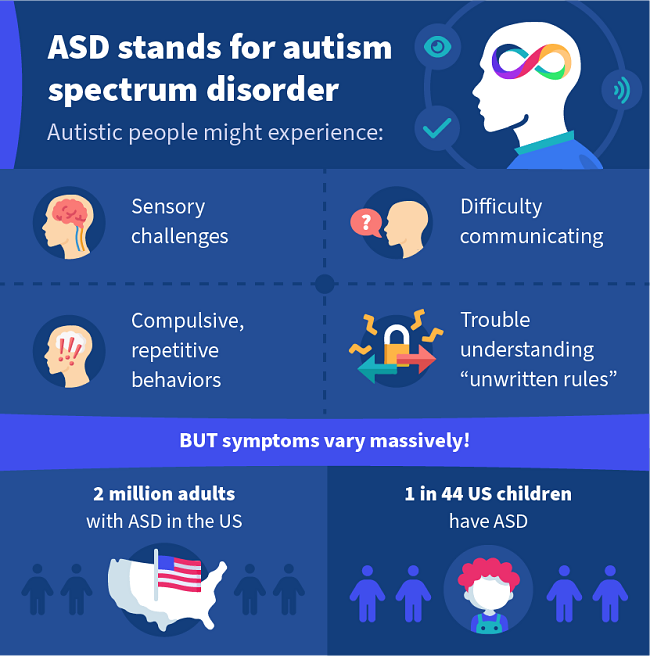
ASD is defined as a developmental disability caused by differences in the brain.
While some autistic people have a known neurological difference like a genetic condition, other causes for ASD are as yet unknown. The current consensus is that there are multiple causes of ASD that combine to alter peoples’ development.
Important Note: ASD is a name for a clinical identification and may not be accepted by everybody on the autism spectrum. Similarly, the diagnostic terms “Asperger’s syndrome” and “high functioning autism” are now considered outdated, and using them might cause offense.
Autism can lead people to communicate, interact, or learn differently, but it’s crucial to recognize that the abilities and characteristics of people on the autism spectrum vary significantly.
Some autistic people may be nonverbal, whereas others may have exceptional conversation skills. Some people need a lot of assistance to carry out their everyday lives with autism, other people on the spectrum live and work independently, and many exist in between these extremes.
Autistic people might struggle to develop and maintain relationships, communicate with others, or understand “unwritten rules” about behavior.
Sensory challenges for autistic people include increased sensitivity or intolerance to bright lights, loud or intrusive noises, or particular tastes and smells. Behaviors such as tics and obsessive compulsions are also often factors in a person’s autism.
The Internet Is Not a Monolith, and Neither Is Autism
When I’m reading and writing about internet safety I often have to remind myself: technology is not a monolith. What do I mean? I mean that a type of technology can’t be inherently good, bad, useless, helpful, dangerous, or safe.

Technology is (with some caveats) whatever its users make of it. The internet is no exception. It presents risks as well as opportunities. It can have negative and positive impacts on people’s lives, sometimes even simultaneously.
I think this is important because it means we can approach internet safety from a place of empowerment rather than a place of fear. It means we can enable ourselves and others to get the most out of the internet safely, rather than simply blocking or restricting it.
The distinction here is that while some risks are specifically related to the internet (they don’t exist anywhere else in the same way), none of them make the internet inherently risky.

There’s a related distinction to make when we’re talking about internet safety for people with ASD: some of the risks I discuss in this guide are affected by autism, but none are inherent in autism.
It’s also worth pointing out that a lot of the risks identified here are things that everybody using the internet should be looking out for. We can all be victims of phishing scams or online bullying, and all children using the internet are potentially vulnerable.
So how is using the internet different for autistic people?
Patrick Sims is a British writer who specializes in autism. He writes about how autistic people use and experience the internet differently for the UK’s National Autistic Society charity. In one piece, he wrote:
The positive thing about computers is that … they are potentially the greatest ever asset for autistic people. They open up a new world of potential: friends, opportunity, and employment. It is perhaps the non-autistic world who has concrete thinking and needs to accept change in terms of redefining friends and socializing.
By highlighting the positives in his article, which also discusses online bullying and radicalization, Patrick was able to explore the middle ground that balances the risks and benefits for autistic people using (neutral) internet technology.
Another way this technological neutrality plays out for autistic people is in the stimulating effects of screen time, especially when it’s interactive. Screens work like a stimulant, just like caffeine.
Autistic people who are more sensitive to this kind of stimulation might find that computer use exacerbates tics, aggression, or feelings of sensory overload. Overstimulation can make autistic people feel particularly emotional and weepy, or give them trouble sleeping.
But computers can also provide a good kind of stimulation for autistic people. The internet provides a safe and comfortable place to learn about favorite topics. It might be easier to communicate online than in person.
The resource, Learning Disabilities, Autism and Internet Safety: A Guide for Parents, written and published by autism and learning disability charities in the UK, quotes a parent of an autistic child who sums up the different ways autistic people can experience the internet really nicely. They said:
My son who is 9 spends almost all of his time online gaming or creating, or lately doing a bit of coding. All self-taught and self-managed. He is home educated and apart from reading, this is his education. He has autism and we want him to learn via his passions and interests.
The internet is his life and offers him fun, friendship, education, challenge, and importantly, communication. I regularly thank my lucky stars that he was born in this era. Sometimes it seems the web or certain aspects of it and its constantly evolving games were made for a neurodiverse world.
I worry, as he gets older, about what he’ll find as his searches widen but there is software I can install that will keep his imagination able to run free but protect him from the darker sides. The education needs to be for parents in how to allow freedom with appropriate protection.
Put simply, a person with autism might use and experience the internet in different ways than a person without autism.
This means that, compared to their parents or friends, for example, autistic people might be more vulnerable to certain risks around being online. It also means that autistic people might find the internet uniquely helpful, or they may be exceptionally well suited to socializing or working in online spaces.
Risks and Opportunities Online for People With ASD
The internet also has a lot of distinct advantages for autistic people and their families, friends, and caregivers. It’s a technology for learning and communicating, and it’s available to nearly everybody around the world.
Just as some people with autism can access unique opportunities online, they can also sometimes be particularly vulnerable to online risks.
Again, this comes from the fact that people with autism might use and experience the internet in different ways than people who don’t have autism. These risks are not inherent to autism or to the internet, and they can crop up in different ways for different people, or not at all.
For example, the direct communication strength that some autistic people have can help them find and build relationships online effectively. But on the other hand, they can also inadvertently offend people.
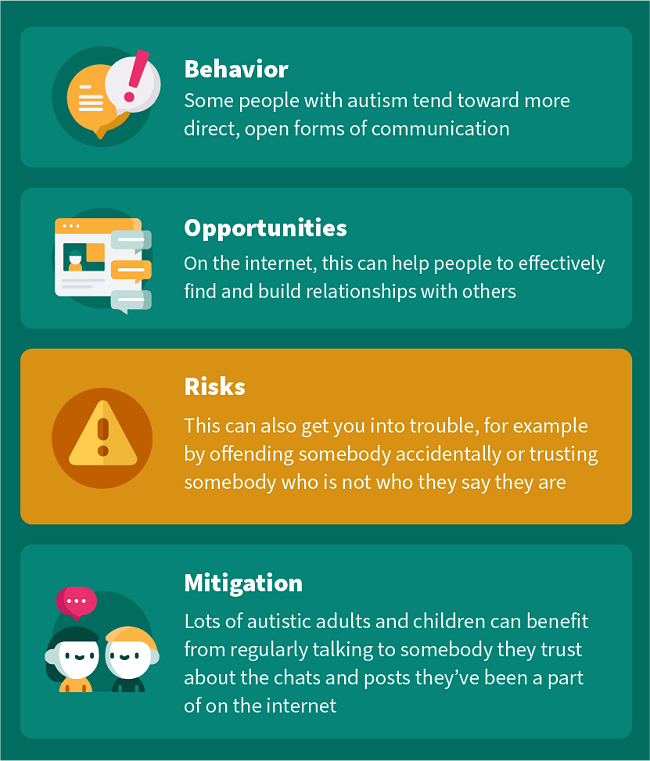
So somebody with this kind of behavior – more direct communication – might find that their communication presents a risk alongside an opportunity, but their autism or the fact that they are on the internet at all is not inherently dangerous.I’m giving this example to show that understanding and mitigating risks should be dynamic – in any risk assessment, it’s important to approach individual situations as individual situations.
You Can Manage Risks More Effectively With a Dynamic Approach
To have an effective dynamic approach to risks and safety, it helps to think about different risk categories to be aware of. This approach is proven to work in helping people with learning, development, or mental health disorders to manage risks.
Gaining a strong knowledge of risk frameworks can enable everybody including people with autism to have a safe relationship with the internet. They also give family members and caregivers a way to spot the signs of risky behavior before it is too late.
Applied behavior analysis (ABA) expert Tahra Cessna says that there are three types of risk categories when it comes to internet safety for people with ASD: conduct, content, and contact:
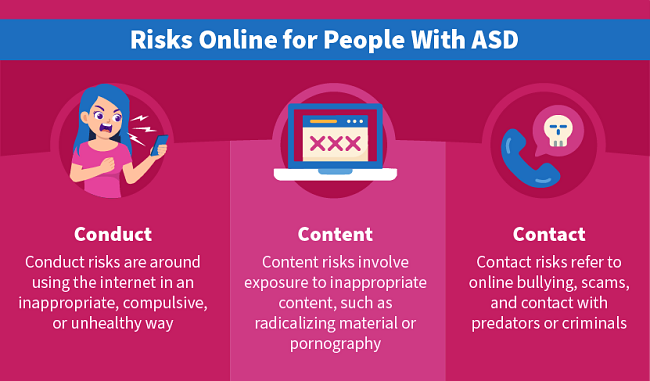
This gives me a framework for identifying risks, which I’ll use in the examples below. But by the same logic, it helps to have a framework for managing risks as well. I believe that the most effective way to build anything like this is to build on top of our existing strengths.
The Strengths That Can Come With an Identification of ASD
The American non-profit Autism Speaks talks about the strengths that can often come with an identification of ASD, in a Tool Kit designed for adults with autism. I’m summarizing, but these are:
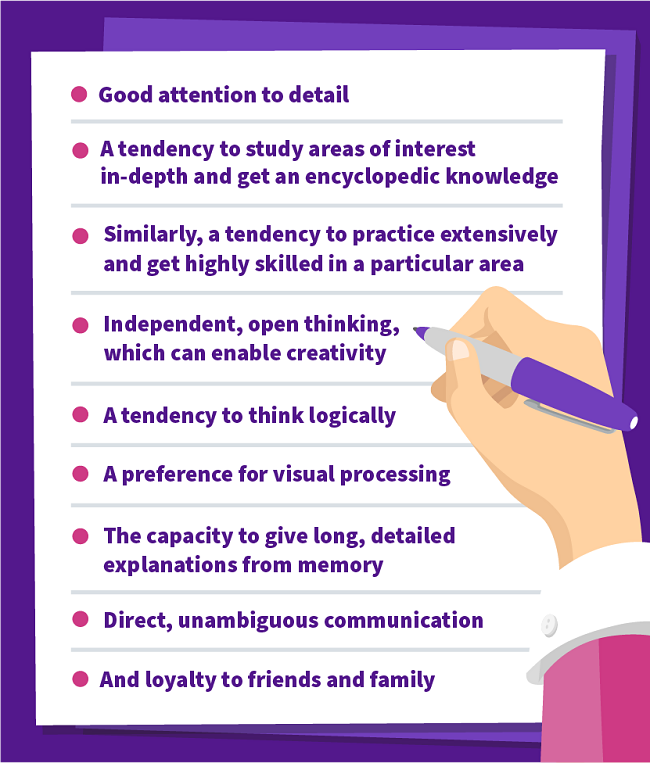
These tendencies are a result of the different ways that autistic people’s brains work. They can enable some autistic people to access unique opportunities online, like researching a favorite topic.
Building on these strengths, I can think of a lot of opportunities online for people with ASD.
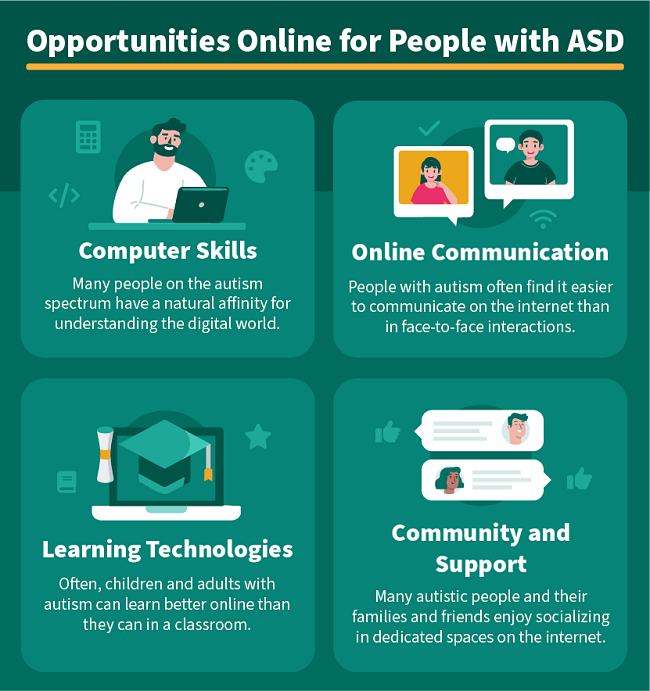
Creating Your Personal, Dynamic, Strength-Based Safety Plan
Of course, I’m being careful here not to paint any big group of people with one brush. The examples in this section and throughout this article are meant to illustrate general points, showing working principles of internet safety.
It’s really important to use guides like this one to make your own internet safety plan, one that’s unique to you. A safety plan that’s personalized and unique to you is a lot more helpful than one that isn’t.
TIP: Safety planning
Think about the specific kinds of risk you want to be aware of (for you or for a family member or loved one), which of your strengths can help mitigate them, and how your support networks can come into play to make your safety plan even more effective.
If we take a look at our unique sets of risks and opportunities side by side, then we can make our safety planning super effective by building on our existing strengths.
The next few sections will tell you about some of the risks and opportunities that autistic people might find online, organized by the “Conduct – Contact – Content” framework.
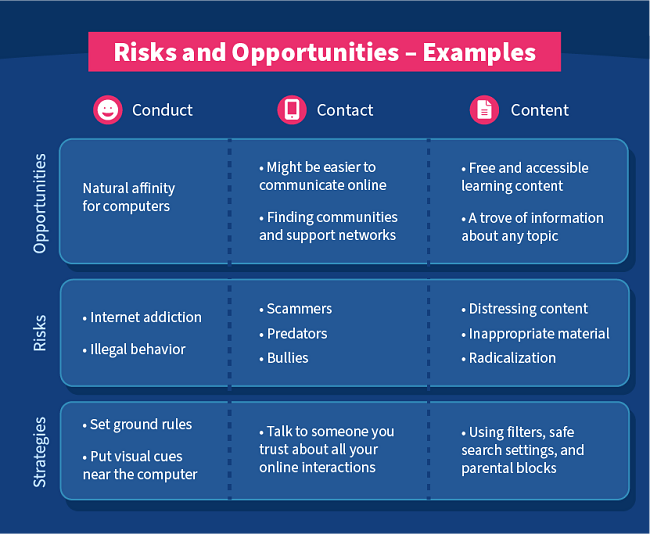
CONDUCT: Computer Skills, Internet Addiction, Illegal Activity
Great Computer Skills Make Some Conduct Risks Tough to Tackle
One of the really positive factors in using the internet for a lot of people on the autism spectrum is that they find they have a natural affinity for understanding the digital world.
The parents of children with autism tell researchers that their children have exceptional computer skills. Children on the spectrum may also learn better online than they do in the classroom.
TIP: The devil makes work for idle hands!
If you’re an autistic person with great computer skills, you can put them to good use to make your family’s internet as safe as possible.
A tendency toward being good with computers can come from a more rational, logical mode of thinking that is common with many people on the spectrum (as well as many people who aren’t). At the basic level of code and ones and zeros, computers operate purely logically.
Being good at computers can make using the internet riskier for autistic people in some ways too. Internet addiction, exposure to inappropriate content, and even committing online crimes without understanding their impacts are all risks to be aware of.
Internet Addiction
There is a flip side to the fact that some people on the autism spectrum have a particular affinity for using computers and communicating online: conduct risks like internet addiction and even illegal activity can have more significant consequences.
Some experts suggest that while computers help autistic people to socialize, they also make it easy to spend too much time taking part in non-social online activities.
Similarly, some people with autism spend too much time on the internet in general. Internet addiction can become a problem for anybody, but research has found an association between autism and internet addiction. (Interestingly, this study also found that people with anxiety as well as autism were less likely to experience internet addiction.)
Internet addiction can lead to increased social phobia in face-to-face interactions and depression, and it can be linked with poor development or low educational attainment.
TIPS: Tackling Internet Addiction
- Set limits with parental controls to limit the time your child spends online. It may sound silly, but I even set them for myself to keep a check on the hours I can use certain apps – especially Reddit and Steam! Obviously, I can override these limits, but it does help me stay focused on how much time I spend on my phone or the computer.
- If you or your child uses the internet too much because it’s a handy and available soother, it might help to make a list of go-to offline activities or behaviors that can help to calm down a meltdown instead.
Autistic people may also be at a higher risk than others of compulsive social media use. Again, this is likely due to the unique and often positive elements of the internet that appeal to many people with autism.
For parents of autistic children, it can be difficult to avoid overusing technology. Sometimes, behavior that is disrupting the rest of the household can be quieted in the short term with online distraction.
There is a chance that young people with ASD can experience hallucinations, paranoia, dissociation, and lose their reality-testing abilities as a result of too much screen time. However, symptoms like these are generally resolved after the internet device is taken away.
Illegal Activity
In some pretty extreme cases, autistic people’s exceptional computer skills, and social naivety have led them to commit serious crimes online.
Just to get the obvious out of the way: I want to stress that it is by no means whatsoever a known trait of autistic people to be cybercriminals. Actually, I found research that shows empirically that autistic people are no more likely to commit crimes online than anybody else.
UK citizens Gary McKinnon and Lauri Love were both subjected to extradition requests by the US government for their roles in hacking US government computers.
McKinnon hacked into 97 computers including NASA and Pentagon networks in 2001 and 2002 and said he was looking for information about alien sightings. American prosecutors claim he caused $800,000 worth of damage to computers, and want to try him on charges that could see him land 70 years in prison.
McKinnon was not previously identified with autism. When he appeared on television news as part of these proceedings, an autism expert contacted his solicitor and a diagnosis was made.
TIPS: Establishing Internet Ground Rules
- If your child is on the autism spectrum, sit down as a family to establish the ground rules for how to behave online.
- You can build on strengths to involve your child in the research process and encourage them to take ownership of the ground rules and their safety.
- Ideally, establishing ground rules before your child gets to use a device will lay the foundation for a safe relationship with the internet as they grow older — but it’s never too late to start!
Lauri Love is accused of hacking into US government websites, defacing them, and stealing the personal details of employees. He won his appeal against extradition to the US, where he could have been sentenced to 99 years in prison and fines of up to $9 million.
In both of these cases, obsession with a particular topic, advanced computer skills, and social naivety got these people with autism into a lot of real-world trouble.
CONTACT: Communication, Nasty People, Nice Communities
It’s Often Easier to Communicate Online
People with autism, as well as some other disorders that affect communication, often find it easier to communicate on the internet than in face-to-face interactions.
Online, people tend to use regular language, slang, emojis, and emoticons consistently to get their point across. For a lot of autistic people, this is much easier to recognize and quickly understand than body language, facial expressions, or tone of voice.
People with ASD have told researchers that they enjoy the control that online communication gives them. It gives the opportunity to process incoming communication and think about their reply, check it over, and then send it in their own time.
The same paper showed that autistic people like being able to express themselves online in a way that feels truer to their identity, without feeling the need to “mask” or hide behaviors linked with autism.
Autism masking is a term that is used to describe when an autistic person hides behaviors related to ASD to blend in or avoid being harassed. Unfortunately, masking can lead to a number of negative effects ranging from a delayed diagnosis to depression or autistic burnout.
According to one study, social media is the communication tool of preference for many autistic people and their families. Meanwhile, a pilot project in Slovenia found that social media could help autistic people feel less anxious about communicating.
In yet another study, autistic people reflected that the internet helped them to reduce the emotional, social, and time pressures they sometimes experienced in offline communication. The researchers dug deeper behind the reasons for this and found that visual anonymity, a flexible conversation pace, and the permanence of text on screen could all be factors.
For the participants in this study, online communication is less complicated than offline communication, and it’s possible to feel a better sense of control when socializing on the internet than in person.
Nasty People: Scammers, Predators, Bullies
Contact risks can come about when people with autism interact with people on the internet who mean them harm. Everybody can be vulnerable to risks like these, but autistic people may be particularly vulnerable if they tend to take people at face value or struggle to understand that online identities can be easily faked.
Online scams like phishing attacks affect everybody from high-flying CEOs to kids on Minecraft. Autistic people are no different. Some autistic people might be more inclined to believe scammers online, but then again people who aren’t autistic demonstrably do this as well. It’s always a good idea to go over the most common types of online scams and how to prevent them.
Similarly, children with autism are vulnerable to predators online just like children without autism.
Like with the other risks, autistic children who are good with computers might be more vulnerable to contact risks like contact with predators as a result of spending more time online and unsupervised. Good family internet practices (see our tips for families below) can really help to reduce or even eliminate this horrible risk.
Unfortunately, people on the autism spectrum are definitely more likely to be bullied online than people who aren’t on the spectrum. Nearly a fifth of children aged 9 to 16 have experienced online bullying, and this increases by 12% for children with special educational needs. In one survey in America, 63% of children with ASD reported that they had been bullied, three times the ratio of children who don’t have ASD.
TIPS: Dealing With Cyberbullies
- Talk with someone you trust if anybody makes you feel bad or uncomfortable on the internet, or in-person
- Don’t feed the trolls. Learn to identify people who are just trying to get a reaction, usually by lying about something or just being a doofus. When you spot them, ignore them!
Nice Communities: Safe Spaces, Support Networks
As well as regular social networks and online communication, a lot of autistic people and their families and friends enjoy socializing in dedicated spaces for them on the internet.
Families of children with autism use the internet to stay informed about their legal rights and available services and treatments. Parents frequently find support and valuable advice from forums, and they can build up their support networks from around the world.
There are also dedicated spaces online for autistic people to build friendships and access support. Sites like Ascent Autism, Autism Society, Open Doors Therapy, and the National Autism Association all provide opportunities for autistic people online. There are links to loads more resources like these at the end of this article.
Accessible web design and plain language are now key features of modern websites. This is great for autistic people and opens up more parts of the internet to more people.
CONTENT: Information, Inappropriate Material, Learning Technologies
The Internet is the Ultimate Information Treasure Trove
One of the biggest opportunities on the internet – for all of us – is the fact that it opens up entire worlds of information to literally anybody with an internet connection and a smartphone.
For a lot of autistic people, this makes the internet a wonderful place to explore pet topics to the nth degree of detail.
Inappropriate Material and Radicalization
Access to pretty much the entire collective information output of the world at your fingertips can be a risky proposition too. For people on the autism spectrum, some of the content you can find on the internet could pose a real danger.
Content risks might include exposure to age-inappropriate sexual material and pornography, exposure to extreme views, or exposure to emotionally distressing content.
Children with autism can be vulnerable to viewing inappropriate content, just like children without autism. Nearly a third of 12 to 15-year-olds have seen something that they found worrying or nasty online, and 16% of 8 to 11-year-olds report the same thing.
If a person with autism is especially interested in being online or especially gifted with computers, content risks can increase. This is because their skills enable them to navigate the internet very effectively, which potentially exposes them to more inappropriate and possibly even illegal content.
TIPS: Avoiding Inappropriate Content
- Turn on safe search settings to stop you from accidentally finding illegal or illicit content.
- Set up internet filters at your router to prevent anybody in the house from accessing specific sites.
- Ask a trusted friend or family member to regularly catch up with you about what you’ve been looking at and reading online.
Learning Technologies
Often, children and adults with autism can also learn better online than they can in a classroom.
Internet-based learning allows for extensive repetition and an individual learning pace. This is good for some autistic children who need more time to learn new things and embed that learning through consolidation.
There is pretty widespread empirical evidence for how effective interventions for children with autism can be when they are based on technology.
The internet and computers are now powerful and well-used platforms for helping autistic people to develop emotionally, socially, and intellectually.
How to Make the Internet Safer
People on the autism spectrum have a tendency toward structure. Boundaries, rules, and clear visual reminders of them can help many autistic people to thrive in potentially risky environments – especially on the internet.
It is important for many autistic people to be able to learn and understand rules like how to behave on the internet, and continually remind themselves of these rules. To help with this, autistic people should have the space to talk openly and freely with their parents, friends, and caregivers about the risks and opportunities of using the internet.
Talking about how we use the internet frequently and candidly is probably the best and simplest way for many autistic people to avoid the different risks I’ve discussed.
Autistic people can take the initiative here by educating friends and family members about the internet, its risks and opportunities, and the way that they individually use and experience it.
The UK charity Cerebra has put together a useful reminder of the main internet safety tips for autistic people. The PLAY IT SAFE points below can help empower people on the spectrum to use the internet safely, confidently, and in a rewarding and enriching way.
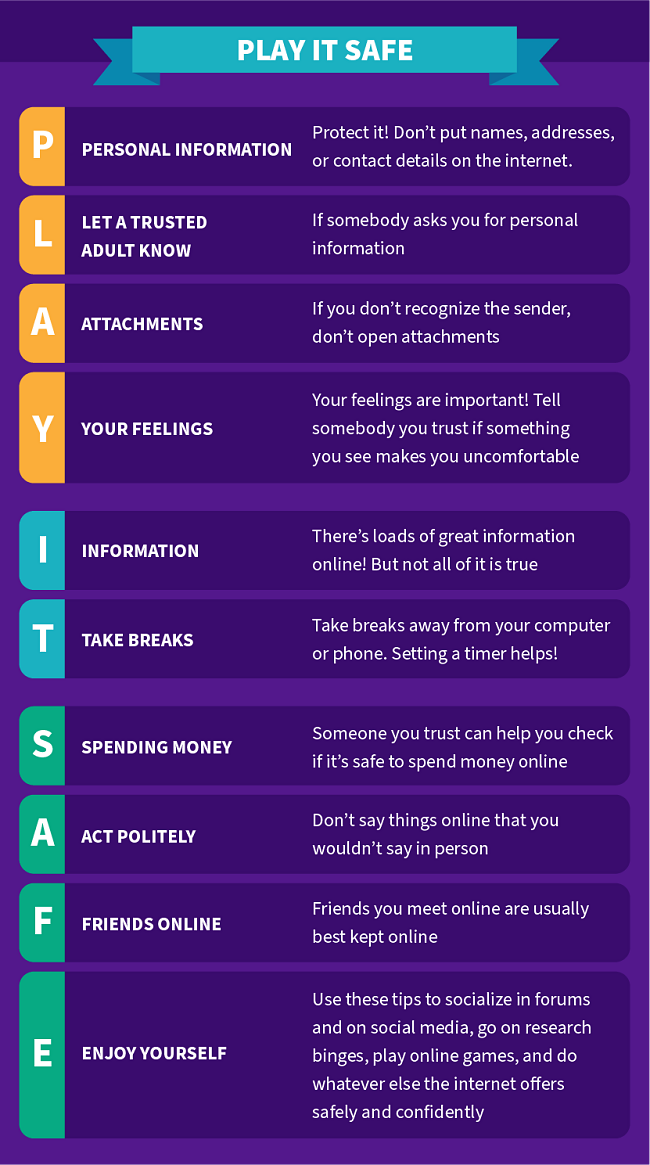
Keeping Autistic Children Safe on the Internet: Advice for Families
There’s a lot of guidance out there for parents and families to help children with autism enjoy the internet safely. The advice below is compiled from lots of trusted sources, which you can find links to in the resources section at the end of this article.
These safety tips are actually useful for any family. Increasingly, children socialize, play games, and study online. In the UK, it’s been found that around 82% of 5 to 7-year-olds are spending over 9 hours online each week; and nearly every 12 to 15-year-old (99%) spends over 20 hours online each week.
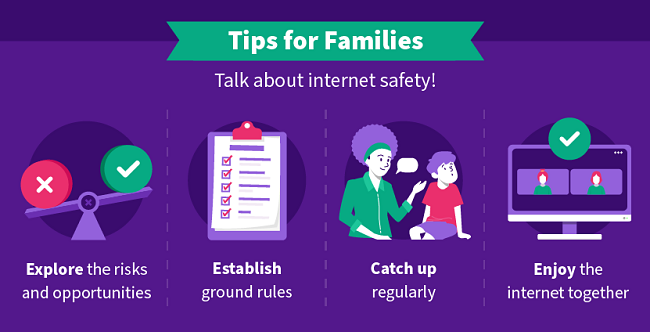
First, if your child’s communication or social skills are less developed, it’s essential to give them explicit instructions for how to act online appropriately from the outset.
Ideally, children will have a chance to understand the rules of internet safety before they get a smartphone or computer access in the first place. But it’s never too late to open up the topic and put a plan in place if they’re already online.
In either case, it’s important to have a frank and open conversation about potential risks and a plan for how to avoid them and use the internet safely before putting any rules in place.
It might be best to explain the risks and opportunities for being online directly and explicitly, and encourage frank and open questions. You can research the topic with your child, by reading guides like this one together, and then create a personalized internet safety plan.
Explain big ground rules like never giving out personal information, or never talking about illegal or illicit topics, and the reasons for having them.
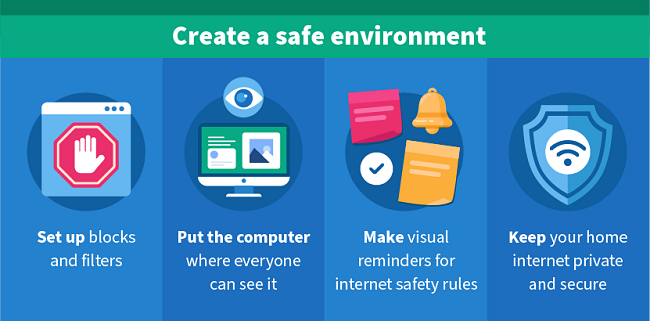
Similarly, it’s recommended to speak openly about the parental blocks and filters you’re using with your child. Explain what they’re there for, and how they’ll restrict the internet for your child.
Other rules you can think about are time limits, letting children use devices unsupervised or not, password sharing rules, and rules for privacy like what if any personal information your child can use online.
You might create an internet contract with your child where you establish rules for internet safety together, using a trustworthy internet safety guide as a basis and personalizing it for your family.
Many children with autism thrive with these clear boundaries in place, knowing they can enjoy the internet without seeing or doing something that will upset them.
By opening up a frank and direct line of communication with your child about internet safety, you also lay the groundwork for keeping them safe and accountable in the long run.
Parents can think of their child’s interactions and experiences online in the same way as they think about their physical whereabouts. “Where are you going?” “With who?” “For how long?”
If you aren’t having regular, open conversations with your child about their online life, the whole world that they’re experiencing could become total terra incognita for you.
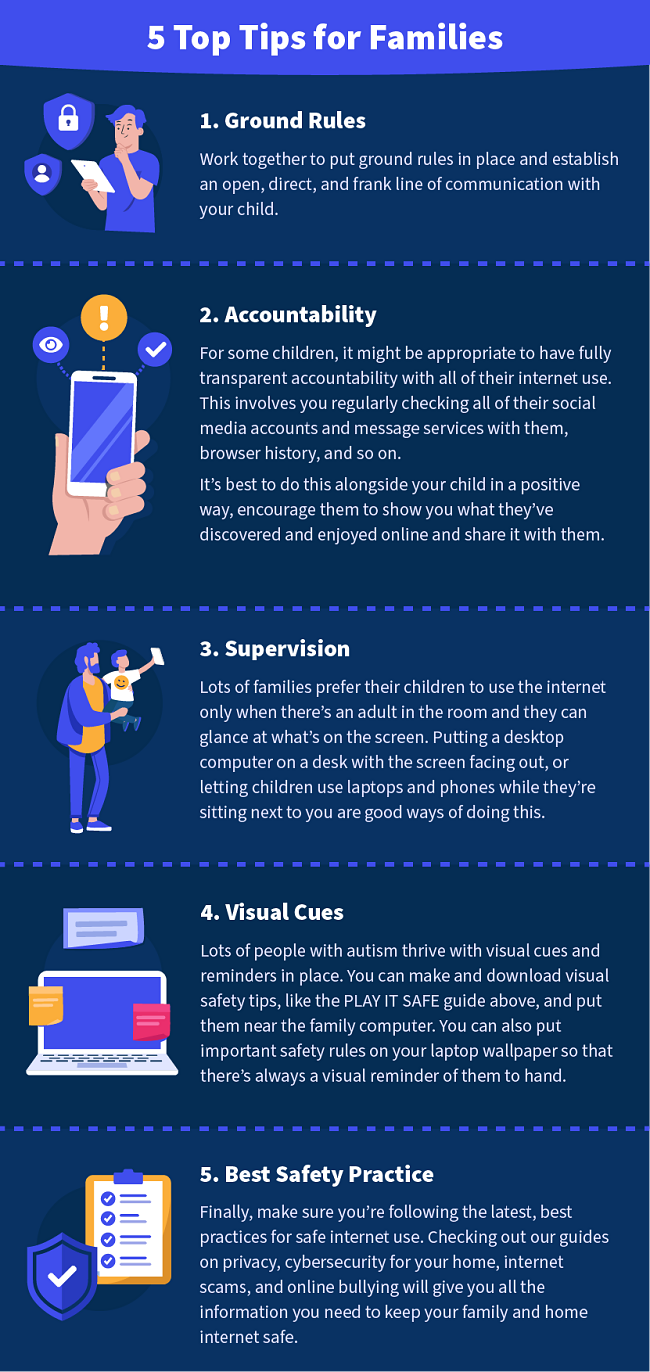
Online Resources
Autistic people and the parents of children with autism benefit massively from a wealth of online resources, advice, and support networks. This is one of the internet’s greatest assets in my opinion: the ability to connect with anybody anywhere in the world.
If you’re a person with autism or you care for one, the chances are that somebody, somewhere in the world, has been in a similar situation to you before. The internet allows us to make spaces to meet and learn from all of the people in the world who can help us.
The support you can find online is available around the clock. You don’t have to head to an office or make a call between 10am and 4pm Monday to Friday but not after 2pm on Wednesday. It’s all just there, literally at your fingertips.
Online Communities
- Talk about Autism: This is a digital platform maintained by the non-profit organization, Ambitious About Autism. The community is designed to cater to the needs of parents, caregivers, professionals, and adults who are on the autism spectrum.
- Wrong Planet: A web community for people with autism. It has a discussion forum, blog, and a collection of articles.
- Online Support Groups: The non-profit Autism Speaks maintains a database of online support groups. Follow the links on the page to find maps of in-person groups in North America.
Internet Safety and Autism Resources
- Learning Disabilities, Autism and Internet Safety: This guide has some UK-specific content, but its general advice is top rate for anybody looking after a child with autism.
- Internet Safety: Planning and Prevention for Adolescents with ASD: This resource includes some great examples of visual cues for encouraging safe internet use with young adults and teens on the autism spectrum.
- Internet Safety: Pathfinders for Autism: This guide summarizes a lot of internet safety tips for people with autism, and especially their families and caregivers.
- Internet Safety for Children with Autism: This safety guide from Jenna Garvey, Clinical Director at the May Center School for Autism and Developmental Disabilities, is aimed at parents.
- Online Safety for Individuals on the Autism Spectrum: These tips from Bobbi Wells, an autism resource specialist are aimed at autistic people of all ages.
General Internet Safety Resources
- Safe Search for Kids: A child-friendly search engine built with Google Search.
- Childnet’s Checklist for Parents on Mobile Phones: What questions to ask before buying your child a smartphone.
- Internet Matters: Issues: The non-profit Internet Matters has published a lot of advice for parents to help children learn about and deal with issues they might face online.
Sources
- Is it autism and if so, what next? — Autism Speaks
- Prevalence and Characteristics of Autism Spectrum Disorder Among Children Aged 8 Years — CDC
- Learning Disabilities, Autism and Internet Safety — Cerebra
- What is Autism Spectrum Disorder? — CDC
- Autism and the internet: risks and benefit — National Autism Society
- Digital Innovation in Education — SciEP
- Software and technologies designed for people with autism — ACM
- Prevalence and Correlates of Screen-Based Media Use Among Youths with Autism Spectrum Disorders — Springer
- The relationship between autism quotient, anxiety, and internet addiction — ScienceDirect
- Examining the Link Between Autistic Traits and Compulsive Internet Use in a Non-Clinical Sample — Springer
- Associations between compulsive internet use and the autism spectrum — ScienceDirect
- Autism and Screen Time: Special Brains, Special Risks — Psychology Today
- A preliminary study of autism and cybercrime in the context of international law enforcement — Emerald
- Profile: Gary McKinnon — BBC
- Lauri Love case: Hacking suspect wins extradition appeal — BBC
- Intersections Between the Autism Spectrum and the Internet: Perceived Benefits and Preferred Functions of Computer-Mediated Communication — IDD
- What Is Autism Masking & Why Does It Affect Women More? — elemy
- What is autistic burnout? — Autism Awareness Centre Inc.
- Connect: the development of an online social network for people on the autism spectrum and their families — Research Gate
- ACE project- Autism Connections Europe — Autism Europe
- The internet: a comfortable communication medium for people with Asperger syndrome (AS) and high functioning autism (HFA)? — Emerald
- Cyberbullying and send module final — Anti-Bullying Alliance
- Use of Technology in Interventions for Children with Autism — APA PsycNet
Attention: WizCase owns the visual and written content on this site. If our cybersecurity insights resonate with you and you wish to share our content or visuals, we ask that you credit WizCase with a link to the source in recognition of our copyrights and the diligent work of our expert cybersecurity researchers.



